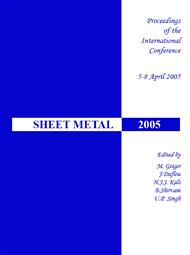p.623
p.631
p.639
p.649
p.657
p.665
p.673
p.681
p.689
Novel Concept of Experimental Setup for Characterisation of Plastic Yielding of Sheet Metal at Elevated Temperatures
Abstract:
In times of highest significance of process modelling and numerical simulation characterisation of material properties is of special importance for tools’ and components’ dimensioning. But in general material properties depend on many different influencing variables, e.g. temperature, humidity and many others. Especially in fields of sheet metal forming the mechanical behaviour of components highly differs according to real stress condition. In particular yield loci combine the information of beginning of yielding with a biaxial stress condition, but nevertheless for many materials they have not been determined yet. For all others the existing values are available only at room temperature. In this paper a novel concept of the experimental setup is shown, with which plastic yielding of sheet metal can be examined also at elevated temperatures. In usual biaxial tension tests cruciform specimen are drawn in plane. The new machine-concept, which is presented in this paper, is based on a punch-load moving perpendicular to the sheet. By clamping the specimen restoring forces are induced, which cause in dependence of special developed tool and work piece geometries defined stress conditions. Using an optical measurement system for determination of strains with CCDcameras of very high frame rate allows exact identification of starting plastification by offline analysis. Experiments at elevated temperatures are realised by local heating with a diode laser and a special optical system to reach a homogenous distribution of temperatures in the forming zone. On the one hand these investigations are necessary for many materials to achieve further information on characteristic properties in warm forming, because their data are only known at room temperature. On the other hand some materials, e.g. magnesium wrought alloys, are mostly formed at elevated temperatures (here in the range of 200°C to 250°C), because of its significant higher formability. Thus, material behaviour must be characterised at these temperatures.
Info:
Periodical:
Pages:
657-664
Citation:
Online since:
May 2005
Price:
Сopyright:
© 2005 Trans Tech Publications Ltd. All Rights Reserved
Share:
Citation:


